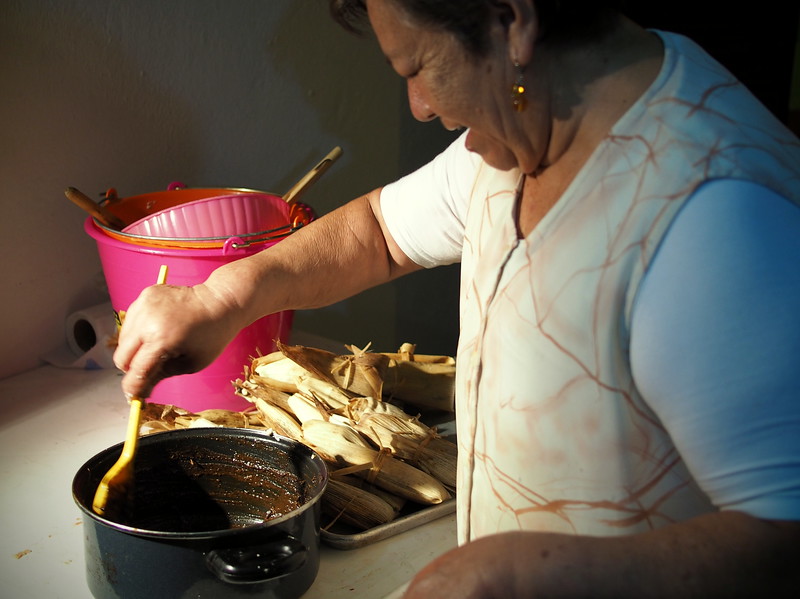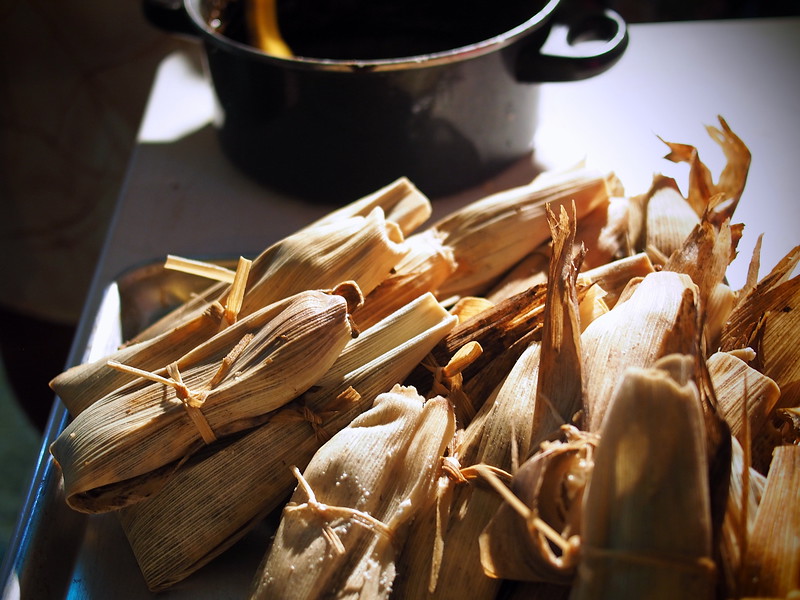Sponsored Listings:
This month I learned that if you found a tiny plastic Baby Jesus in your slice of Rosca de Reyes (Three Kings Cake) on January 6, that you were firmly in charge of bringing your entire family a haul of tamales on El Día de la Candelaria (Candlemas Day) on February 2. This is not a suggestion, either. It is a fact. You find the baby Jesus, you bring the goods to your family in Oaxaca.
My winter base of Oaxaca de Juarez: colorful, dry, and full of tamales!
Candlemas in Oaxaca City
My landlady Yolanda swept past me as I tried to walk up the stairs to my apartment in Oaxaca, asking me how I felt about tamales. I feel how most people feel: that they are delicious, that I mourned my waistline when I discovered they were full of pork lard, and that the Oaxacan version, filled with a deep, dark mole sauce, was truly superb. Her eyes lit up, and she began to talk.
On January 6, most Mexicans celebrate Three Kings Day (El Día de los Santos Reyes), commemorating the story of the three wise men who visited baby Jesus with frankincense, gold, and myrrh. As part of the holiday, families eat the Rosca de Reyes, a sweet, braided loaf of egg bread and candied fruit baked with tiny dolls representing Jesus hidden within them. The tradition of the Rosca cake is one that was brought over by the conquistadors, and was a holdover from the Middle Ages that is still celebrated in parts of Spain and France. And as I said, if you are the one to find a figurine in your cake in Oaxaca, you are feeding that same group of people for Candlemas Day.

A GIANT Rosca de Reyes in Oaxaca’s centro, just near the Santo Domingo church. Photo by my friend Kathy Watts.
I wasn’t yet in Oaxaca on Three Kings Day, but I am glad I got to watch the city gear up for the follow-up. Tamale stands around town were packed with people buying in bulk for their families and friends, but in my apartment complex, it was my landlady who took over tamale-making duties, along with her husband’s family next door. Yolanda was making the mole negro (black mole) and rajas (roasted pepper and quesillo cheese) tamales, and the neighbours were in charge of the sweet tamales with pineapple.
February 2 also marked the official end of the Christmas season, where what remained of holiday decorations and wreaths were shelved until December. Houses that set up nativity scenes put them away and in the process whisked the Jesus figure from them and dressed him up before bringing him to church. Those who did not have a nativity scene often possessed a Jesus figurine regardless, who was dressed up and brought to church to receive blessings.
Thus El Día de La Candelaria celebrations included not simply tamales but the more important presentation of the Jesus dolls to the local parishes. I was told this tradition reenacted Mary’s presentation of Jesus in temple forty days after his birth in ancient times. Church courtyards were absolutely packed with people, most holding a dressed-up doll about the size of a 40-day old infant, listening to the sermon as the holiday ended.
Then, because Mexico, the firecrackers continued for hours.
Tamales at for Candlemas
Tamales are found throughout Mexico, with a dizzying amount of types and traditions that accompany them. They are made from maize (a coarse cornmeal flour) and were cooked by all of the original inhabitants of Mexico, long predating the arrival of Old World conquerors. Per Karen of MexConnect:
The great variety of tamales has carried over to this day; ethnographers have counted forty two different kinds, including the famous zacahuil prepared by the Huastecan people. This tamal is 3 feet long, weighs about 150 pounds, and requires most of the leaves of a banana tree to wrap it. The zacahuil and the muchipolloof the Yucatan are exceptions to the tamal-making rule in that they are baked either in the ground or in a bread oven rather than being steamed. Other unique tamales are the pastel-colored versions prepared by the Otomi people near San Miguel de Allende and the fresh fish clapiques of the coast, which have been prepared since the time of Moctezuma II.
While pre-Hispanic tamales were made with the ground maize and oils from plants, the current iterations are made with pork lard instead, which arrived in Mexico along with the Spanish import of the pig.
For Candlemas, my landlady made a black mole sauce, rajas in another pot, and then set up a tiny table in the corner of the kitchen to put together the tamales.

Cheerful tamales-making in progress!

Close up of the tamales.
If you want to try my favorite — rajas — Serious Eats has a recipe here.
For a more extensive cookbook of Oaxacan food, Diane Kennedy’s incomparable Oaxaca el Gusto is where you need to be. Coming in at 10 pounds, the el Gusto book is too heavy for me to travel with, but I devoured it (SEE WHAT I DID THERE) at my dad’s place before leaving for Oaxaca and I can’t wait to try more recipes from it upon my return.
Hospitality and my Apartment in Oaxaca
I will be writing a full guide to Oaxaca once I get more familiar with the city, but suffice it to say that my time here has been made more interesting because the hospitality of my landlady and her husband Pablo. Between lending me her old cookbooks so that I can review some of the recipes, to loading me up with extra blankets when it was cold, to ensuring that I had ample honey and ginger when I was felled by a 10-day Mexican flu, she has been a constant presence in my life.
I don’t think she realizes I’m in my 30s but I appreciate that she takes care of me when I’m sick.

My landlady’s temporary book loans.
Pablo is also a force to be reckoned with. He has a permanently hoarseness due to the removal of tumors on his larynx, and as a result his gravely voice is unlike any other I’ve heard. He and Yolanda call me Yeni, since Jodi was too confusing to pronounce — this is common in Latin America, where Jodi becomes a phlegmy “ho-di”. I simply go by Yeni here now, and giggle when I hear Pablo’s rumbling “Yeeeeeeeni?” calling at me from the bottom of the stairs.
The exception to Pablo’s deep voice is when he laughs, an incredibly high-pitched, pure and joyful laugh that makes anyone in the vicinity smile. His sense of humor has proven entertaining also; he waited for me to return from the SuperBowl viewing, only to pop out from the stairway’s landing, going on about “Los Broncos” and gesticulating wildly.
The apartment I’m in is as quirky as its owners. It’s a two-bedroom place that my friends have nicknamed “The Crow’s Nest” because has a tiki-style ceiling and a bit of a problem with the roof, specifically that the walls in the living room don’t seem to fully attach to it. This would be fine if Oaxaca’s nights were warm all the time, but I suspect that the aforementioned Mexican flu came from those 4C nights where my living room was a wind tunnel. My mum, who visited this month, has a series of photos with me working at my laptop in a hat, scarf, and coat.
I’m sharing this place with Shannon from A Little Adrift, who I met in 2010 in New York and who has been one of my best friends ever since. We’ve not been in the same city for years, so we decided to make our way to Oaxaca for this winter, recruiting a few other friends in the process.
The apartment was possibly an outer deck that they converted into bedrooms, which might be why my bedroom (unlike Shannon’s) is outside the front door. When I have to use the washroom in the middle of the night, I stumble out of my room bleary-eyed, and try to quietly unlock the front door. The water pressure is also non-existent, the bathroom smells like dead people, and the church next door bongs its bells 37 times at 6:41am on Sundays, as well as 37 times whenever someone in the community passes away.
Oh, and next door is a compound with a huge dog named Jimmy, who barks deeply and furiously when disturbed. Like clockwork, the same sequence happens: Jimmy goes nuts, the other dogs in the area go nuts, Jimmy’s owners yell, “Jimmy! Callate!” (Jimmy, shut your mouth!). Now, when he starts barking Shannon and I quietly say, oh Jimmy… and sure enough poor Jimmy is told to shut it.

My apartment in the late afternoon light
These aren’t complaints, of course. The adjustments to day-to-day living are part of what makes experiencing a new place fun. As with chicken buses in rural Laos, singing karaoke on a ferry boat that got stuck in Myanmar, or celebrating a birthday with nomads in the Gobi Desert in Mongolia, the intensive learning in travel comes from situations that aren’t smooth sailing. Of course, this is a far smoother situation than a bus packed with chickens, and Yolanda and Pablo make it even more entertaining.
In my weeks here, I have spent half of it sick with the flu, and half of it stuffing my face with every food imaginable. It’s a celiac’s paradise, all corn and pork lard and stringy perfect cheese. The historic center of Oaxaca is a delight of colors and cobblestones, and my rationale for coming here — a new country with foods that would be safe for me to eat — seems like it was a good bet after all. Even if I have to type with a hat on sometimes.
More from Oaxaca soon!
-Jodi
Source: legalnomads.com










